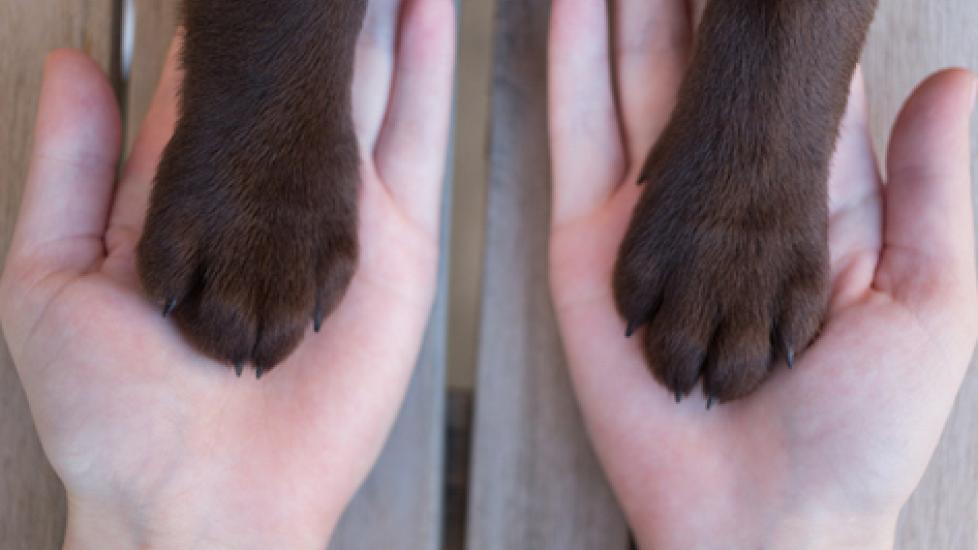Does Reflexology Benefit Dogs?
By Heather Larson
Alternative medicine practices like massage and acupuncture have proven beneficial for canines. However, the jury is still out on reflexology. A type of massage that’s based on the concept that reflex points in the feet, hands (paws), and head are linked to every part of the body, reflexology is used on both humans and canines. By massaging those points, it is said the practitioner releases tension and can alleviate some medical conditions in the patient. So far, no studies exist on how this treatment affects pets.
In fact, Dr. Narda Robinson, president and CEO of CuraCore Integrative Medicine & Education Centers in Fort Collins, Colorado, says there’s no evidence that the reflexology “maps” commonly used in human treatment have any validity insofar as relating areas on the bottom of the foot to zones elsewhere in the body.
“Transposing a system that is, essentially, invented out of the blue and then applied to the vastly different canine foot, is fanciful at best,” says Robinson.
Because of opinions like Robinson’s and a lack of studies, finding a reflexology practitioner for your dog may be difficult. However, you can safely try some reflexology techniques yourself. If nothing else, it’s another good way to connect with your dog.
Bonding with Your Dog
The most common form of reflexology involves applying pressure to different areas on the bottom of the canine foot.
“Not all dogs like their paws touched,” says Alison Zeidler, a registered Canadian reflexology therapist and instructor of canine reflexology. “Slowly gain their trust by applying gentle strokes from their head and shoulders down their leg and past their paw. That usually shows them how relaxing the touch is and then most dogs will allow you to work their legs and paws.”
Zeidler offers holistic therapies to both people and their pets, including horses, dogs, and cats. She says reflex points in the paws, ears, and head correspond to every joint, muscle, gland, and organ of the body. By stimulating those points, you or a reflexologist can influence that related body part by bringing it into a more relaxed, balanced state.
Benefits of Foot Manipulation
Reflexology reduces stress, Zeidler says. “Just like with humans, poor diet, lack of exercise, and anxiety can affect our pet’s health and well-being. That can result in illness or behavioral issues.”
Zeidler also incorporates other bodywork techniques and energy healing methods into her reflexology sessions with canine clients. These practices encourage relaxation, she says, and also promote circulation, increased energy, trigger the parasympathetic nervous system, encourage deep breathing, and reduce aches and pains.
“By bringing the organs and other systems of the body back into a more balanced state, reflexology promotes self-healing,” Zeidler says. “It’s a great way to help the body deal with many illnesses or conditions.”
Risks and Dangers of Reflexology
Reflexology may promote self-healing, but that doesn’t mean reflexologists can diagnose, treat, or cure any illness or condition, Zeidler stresses. If they say they can, beware.
One of the main downsides of reflexology is that your dog may not like it. “I do think it would be difficult to do on pets because many of them don’t like their feet touched, much less strongly stimulated,” says Dr. Doug Knueven of the Beaver Animal Clinic in Beaver, Pennsylvania, who doesn’t use reflexology. “It has been my experience that reflexology hurts.”
That’s why it’s imperative to monitor your dog’s reactions when you’re performing reflexology on him. “Listen to and watch your dog,” Zeidler says. “If he shows signs of resistance or anxiety, like curling his lip or holding his breath, or looks worried, slow down or stop. Never force your dog to accept any kind of bodywork because that defeats the purpose and you’ve broken the trust with your dog.”
Acute or serious illness or injury require diagnosis and treatment by a veterinarian and should not be initially addressed with reflexology.
Calming Dogs with Reflexology
By gently holding or using a very slight pressure and release motion with your thumb on the solar plexus point (under the middle of the large paw pad on any foot), you can help calm your dog. You can also soothe your dog by gently rubbing the tips of his ears, Zeidler says.
Others say rubbing the entire ear can be calming. On her site, Positively.com, dog trainer Victoria Stillwell says that canine ears have many nerve endings. When massaged, those nerve endings can cause the release of endorphins into your dog's body, increasing his relaxation.
Stillwell suggests moving your finger in a slow, circular motion from the base of the ear outward. Notice where he seems to enjoy the massage the most so you can concentrate there.
Knueven says he thinks of reflexology as a microsystem within acupuncture. “For example, auricular acupuncture uses points within the dog’s ear,” he says. “There are points that can affect every part of the body in the ear, just like the reflexology points on the feet.”
Robinson says veterinarians are drawn to evidence-based physical medicine approaches for dogs like acupuncture, body massage, and photomedicine. Canine reflexology lacks objective value, she says.
Still, Zeidler claims it’s a positive way to spend some quality time with your dog. “Reducing stress helps create a greater sense of well-being for both you and your dog,” Zeidler says.
